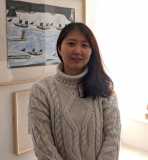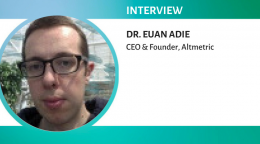"Even good science poorly communicated can become bad science." - Christina Cho, Postdoctoral Research Associate, Yale University School of Medicine

I am in conversation with Christina Cho (@ChochrPhD) to understand what science communication means to researchers and how researchers can increase their visibility in their field.
Chri stina Cho is a postdoctoral fellow at Yale University School of Medicine, USA, where she is currently researching metastatic melanoma and lung cancer. She has expertise in fields such as cancer biology, cancer immunology, and matrix biology, and has led research projects for over 10 years. She has been involved in various activities in the field of academic research and has authored and co-authored a number of academic publications in international journals.
stina Cho is a postdoctoral fellow at Yale University School of Medicine, USA, where she is currently researching metastatic melanoma and lung cancer. She has expertise in fields such as cancer biology, cancer immunology, and matrix biology, and has led research projects for over 10 years. She has been involved in various activities in the field of academic research and has authored and co-authored a number of academic publications in international journals.
She is especially passionate about science communication and gives talks about her research to the public whenever she has a chance. For example, she gave a talk about her research in the Science in the News (SITN) video, produced by Yale Science Communication, which aims to ignite scientific engagement across diverse communities. Also, she was one of the winners of the Share Your Research 2021 competition hosted by iBiology.
Earlier this year in August, she conducted a webinar for Editage Insights Korea on “How to communicate effectively with international journal editors.” The webinar was so well received by Korean researchers that we wanted to get Christina’s insights into a more advanced topic. So, this time, we talked with her about the importance of science communication and research promotion.
Q 1. You are engaged in various academic communication activities such as workshops, webinars, and lectures in addition to research and paper work. I also noticed your latest #shareyourresearch activity! Can you tell us in detail what kind of activities you are doing for academic communication and research promotion?
I am actively working on becoming a better science communicator. I have taken several workshops and courses, and I always ask my peers and mentors to proofread my work and provide feedback (positive and negative). Importantly, I present my research to the general public through various programs like Yale Science Communication’s “Science in the News,” and through iBiology’s Share Your Research Competition.* My talk for iBiology is will also be published online sometime in 2022.
I also teach workshops on how to write manuscripts in English for non-native English speakers. I provide these workshops because there are brilliant scientists all over the world, and sometimes the only thing stopping them from sharing their work is the language barrier. This should not be the case. I hope one day that every journal has a “translate” option within the article when viewed online. This way, the burden of translation is not placed on the scientist, but on the journal that is disseminating the work.
Q 2. You must be really busy with research and paper work. So, what is the reason you are actively participating in these science communication activities? What is the importance of these activities and research promotion for you as a researcher?
I firmly believe that good science requires good science communication. Even good science poorly communicated can become bad science. A good example is our current global pandemic and the general publics’ hesitancy to get vaccinated. The data is good; it’s convincing: all the available COVID-19 vaccines protect people from COVID-19–related hospitalizations and death with 90% efficacy. 90%. 9 out of 10 people will be protected.
But why do people still hesitate to get vaccinated? Why are people afraid of these vaccines? Because it’s new? No, people buy new technologies all the time without second-guessing the dangers of new technologies. People take new drugs—a great example are people who are willing to take the new monoclonal antibody against COVID-19. The reason behind the hesitancy and distrust is poor communication and bad messaging.
The graphs are complex. The words we use to describe the data are complicated, specialized, and sesquipedalian. Did you stop at that word? Sesquipedalian? It means, to overuse big, long, complex words. Usually seen in academia and research and used by people to feel “smarter” than their audience. After all, when no one knows what you’re talking about, and only YOU understand it, doesn’t that mean you’re smarter? No, it means that no one is listening.
We as the holders of information, we as the discoverers of NEW information—let me emphasize this point: we—as the PRIVILEGED holders and discoverers of information—are RESPONSIBLE for relaying that information in a way that is easy to understand AND convincing. Whether it’s information regarding global warming, or how a new virus is spreading, or how cancers develop, we as scientists need to be better at messaging. Because if the audience (the general public) cannot understand it, they will not believe it, and all the work we are doing—to improve the quality of life of humankind—is kind of pointless.
Q3. Increasing one's visibility as a researcher as well as promoting one’s research can offer various advantages, such as increasing research collaboration opportunities. Can you advise on how to increase this visibility and its benefits in the social media era?
Oh man, this is a great question. In fact, the idea of building your social media presence to promote your research is a very NEW thing, and a lot of people in my age group (mid 30s, early 40s) and older are quite hesitant about increasing their social footprint. Younger scientists—those who are currently in graduate school or just finishing—are way more adept at social media, and several have really harnessed the power of social media to improve their visibility as scientists. That said, building your social media presence is a FULL-TIME JOB, if you want to do it right.
According to marketing/advertisement experts, if you want to truly build your social media presence you need to do the following: (1) for Twitter: post new tweets 3–4 times a day, and (2) for Instagram/Facebook/TikTok: put up a new post at least once a day. Oh and here’s the kicker: you can’t re-use content. In other words, your Facebook post has to be UNIQUE and DIFFERENT from your Instagram post.
Those are some great tips that every researcher can follow! Don’t mind me saying this, but that also sounds like a lot of work!
Yes, it is a LOT of work. It is time- consuming, and frankly, if you are a postdoc, or junior faculty, you will not have the time to do this. So, set realistic expectations. You probably won’t become Instafamous, BUT you can use social media to advertise your work and meet collaborators. The easiest thing to do is join twitter. There is an ENTIRE Science twitter world. I’m in the “Biology” twitter world, and I follow scientists from all over the globe.
Another thing to do is use Instagram to publicize your work—talks you give, papers you publish, courses you teach—without making “new” content. You can literally use Instagram like a newspaper, announcing your recent accomplishments and your upcoming events. The takeaway message is this: get a Twitter and an Instagram account, but don’t start a new full-time job trying build your social media presence.
Q 4. Finally, researchers are familiar with communication mainly with experts or researchers in the same field. Is it also necessary for them to learn how to communicate research with the general public? If yes, do you have any tips for how they can do this?
100% yes. Definitely yes. You need to be able to communicate your work to the general public. You need to be able to communicate your work to people outside of your field. The big journals—Nature, Cell, Science—they are read by people in every field of science, not just yours. If you want to reach a large audience, your content has to be widely accessible, and when I say accessible, I mean easy for all different types of people to understand.
Here are some tips: when you write a manuscript or review article, have a colleague –who is NOT in your field of research—read it. If a fellow scientist struggles to understand (a) why your research matters, (b) what questions you are addressing, (c) how your research will impact the public, then you need to rewrite that paper. You should find ways to “share your research” with the public. If there are high schools, college, elementary schools, or libraries that like to provide FREE educational courses/seminars, volunteer to give a talk.
But the most important thing you can do is LISTEN and PAY ATTENTION to your audience. If you’re giving a talk, watch how they react. Are they following you? Do they look lost? Are they asking questions? Do they seem interested in what you’re saying? If not, ASK your audience what you could change to make your talk more interesting and easier to understand. If you’re writing a manuscript, don’t be offended or get upset if you receive negative feedback. Your goal is to have the reader come to same conclusions as you. You need to hold their hand and walk them down the specific path you set in front of them. If you give them bad directions and they get lost, it’s your fault.
Thank you for speaking with us, Christina Cho! This conversation gave some really powerful and clear insights into the importance of science communication.
How did you read this interview? Please share your thoughts or more questions in the comments section below :-)
* Christina’s presentation for “Science in the News” is available here and her talk can be viewed at the 23:10 mark.
Comments
You're looking to give wings to your academic career and publication journey. We like that!
Why don't we give you complete access! Create a free account and get unlimited access to all resources & a vibrant researcher community.

Subscribe to Career Growth






